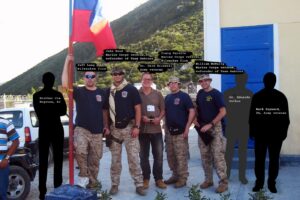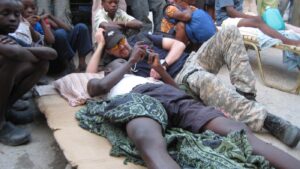On January 13, 2010, a small group of military veterans, first responders, and emergency medical personnel led by Marine Corps veterans Jake Wood and William McNulty decided to respond to the humanitarian crisis caused by an earthquake in Port-au-Prince, Haiti. This was the birth of Team Rubicon, a day we now call “Go Day.” Every year we celebrate by remembering the example set by our founders and encouraging one and all to take action for others. As we enter a new year and the challenges ahead, it’s important we remain true to our roots and keep alive the values demonstrated by those first Greyshirts.

The original team of eight. Many of these team members met for the first time in Haiti, yet they functioned like a well-oiled machine.
Our identity as an organization stems from the experience of military service. In fact, both of our co-founders had only recently begun to settle back into their civilian lives when they were confronted by the horrifying images coming out of Port-au-Prince. Moved by what they saw, they once again felt the urge to serve and knew the skills that they had learned in the military would prove invaluable. Their training and familiarity with chaotic environments gave them the ability to reach survivors and begin providing relief in the crucial days immediately following the earthquake.
Today, initiative and grit gained through military service remain part of our DNA. We approach every operation with the mentality “Get Sh*t Done.” And when looking for where to deploy, we always seek out the hardest-hit communities where we can make the largest impact. Much is asked of our volunteers, but for them, stepping up when duty calls is nothing new. Fueled by compassion and an indomitable spirit, they bring relief to their neighbors in need during the most trying of times.

Mark Hayward, former Army Special Forces medic and one of the original eight Team Rubicon volunteers, pauses with a patient in Haiti in 2010.
From the beginning, the team realized they could not pull off their operation without support. Early dispatches from Haiti show they understood the importance of sharing their story, giving a face to survivors, and inviting each reader to discover what moved them. Because while not everybody can deploy to a disaster zone, anybody can serve with their generosity. The harrowing, sometimes funny, beautiful, and heartbreaking messages they shared with those back home set a standard for honesty that we strive to maintain with donors, Greyshirts, and community members today.
We appreciate each individual who chooses to undergo this journey with us and recognize that every dollar given and hour volunteered represents a sacrifice. In order to respect those contributions, we have consistently made transparency a key tenet of our organization. This began with the first After Action Report that the team released when they returned from Haiti (which you can read here) and continues with storytelling from the field and financial reporting. It’s one more way we’re using our story to encourage others who feel called to serve.

Greyshirts respond to Hurricane Harvey.
January 17th, 2010 marked the day the team began their work in earnest. On the rubble-filled streets of Port-au-Prince, they witnessed sorrow, sickness, and misery on par with any battlefield they’d known. But in the eyes of survivors entering their makeshift hospital, they also found hope. That hope proved to be a guiding light for the team. It showed them that no matter how dark the situation became or how insignificant their efforts seemed; they were making a valuable contribution. And for many of the survivors they aided, it meant the difference between life and death.
Instead of leaving Haiti feeling overwhelmed and powerless, the team returned home with the belief that they had stumbled upon something viable and necessary. By pairing military veterans with relief efforts, they could start a movement that would reshape the paradigm of disaster response. Inspired by the simple principle of bringing hope to people on their worst days, that movement has touched the lives of countless thousands who have heard the words, “I’m from Team Rubicon, and I’m here to help.”
The most difficult part about our line of work is that everything we accomplish is precipitated by disaster, yet we refuse to succumb to despair. Whatever the next years bring, we will continue to follow the lead of our founders. There’s no right time for catastrophe to strike, and no perfect situation in which to respond, but when people are in need, those with the ability to help must. We at Team Rubicon will continue to go because it’s what we’re built for.



